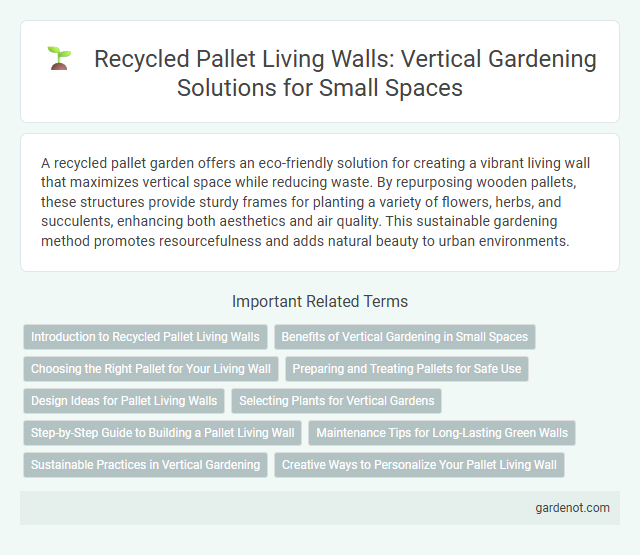A recycled pallet garden offers an eco-friendly solution for creating a vibrant living wall that maximizes vertical space while reducing waste. By repurposing wooden pallets, these structures provide sturdy frames for planting a variety of flowers, herbs, and succulents, enhancing both aesthetics and air quality. This sustainable gardening method promotes resourcefulness and adds natural beauty to urban environments.
Introduction to Recycled Pallet Living Walls
Recycled pallet living walls transform discarded wood pallets into sustainable vertical gardens, offering an eco-friendly solution for urban gardening. These structures provide efficient use of limited space while promoting biodiversity and improving air quality in indoor and outdoor environments. Utilizing reclaimed materials reduces waste and supports sustainable horticulture practices.
Benefits of Vertical Gardening in Small Spaces
Vertical gardening using recycled pallet gardens maximizes limited space by transforming unused walls into lush, productive green areas. This sustainable approach enhances air quality, reduces urban heat, and supports biodiversity while minimizing the carbon footprint through upcycling pallets. Ideal for small urban environments, vertical gardens increase crop yield per square foot and promote eco-friendly living.
Choosing the Right Pallet for Your Living Wall
Selecting the ideal pallet for a recycled pallet garden hinges on ensuring it is heat-treated rather than chemically treated to avoid harmful toxins in your living wall. Opt for sturdy, well-constructed pallets made from hardwoods like oak or maple, which provide better durability and support for plants. Properly preparing and sealing the pallet also enhances longevity and prevents moisture damage, promoting a healthier, more sustainable living wall.
Preparing and Treating Pallets for Safe Use
Preparing and treating pallets for a recycled pallet garden involves thorough cleaning to remove dirt, debris, and potential pests, followed by sanding to eliminate rough edges and splinters. Applying a non-toxic sealant or food-safe wood preservative ensures protection against moisture and mold while maintaining safety for plants and humans. Selecting heat-treated pallets labeled with "HT" guarantees chemical-free wood, reducing the risk of harmful substances leaching into the garden environment.
Design Ideas for Pallet Living Walls
Recycled pallet gardens offer a sustainable and creative solution for pallet living walls, maximizing vertical space with eco-friendly materials. Design ideas include arranging pallets in tiered layers for cascading plants, integrating modular pockets for herbs and succulents, and customizing finishes to complement outdoor or indoor aesthetics. Incorporating drip irrigation systems and varied plant textures enhances both functionality and visual appeal in pallet living wall installations.
Selecting Plants for Vertical Gardens
Choosing plants for recycled pallet vertical gardens involves prioritizing species with shallow root systems and drought tolerance to ensure healthy growth in limited soil spaces. Succulents, ferns, and herbs like thyme or mint thrive well in pallet gardens due to their adaptability to vertical environments and variable moisture conditions. Incorporating native plants enhances sustainability by requiring minimal maintenance and supporting local biodiversity in living wall installations.
Step-by-Step Guide to Building a Pallet Living Wall
Start by selecting a sturdy, clean recycled pallet and reinforcing it with extra wood if needed to support plant weight. Attach landscaping fabric to the back and bottom of the pallet to contain soil while allowing drainage, then fill it with a mixture of potting soil and compost for optimal plant growth. Finally, choose a variety of small plants or succulents, carefully plant them within the pallet slats, and secure your pallet living wall vertically against a wall or fence for a sustainable, green decorative feature.
Maintenance Tips for Long-Lasting Green Walls
Recycled pallet gardens require regular watering and careful drainage management to prevent wood rot and promote healthy plant growth. Applying a weather-resistant sealant to the pallets helps extend their lifespan by protecting them from moisture and pests. Pruning plants and replacing any damaged or diseased foliage ensures a vibrant and thriving living wall over time.
Sustainable Practices in Vertical Gardening
Recycled pallet gardens exemplify sustainable practices in vertical gardening by repurposing wooden pallets into functional plant holders, reducing waste and minimizing the need for new materials. These vertical structures promote efficient space usage and enhance urban greenery while fostering eco-friendly gardening techniques. Utilizing recycled pallets supports a circular economy and encourages resource conservation in home and community gardens.
Creative Ways to Personalize Your Pallet Living Wall
Transform your pallet living wall into a unique green space by incorporating recycled materials like repurposed tin cans, glass jars, or old wooden boxes as planters, adding both texture and character. Use a mix of herbs, succulents, and colorful flowers to create a vibrant and diverse garden that reflects your personal style. Integrate decorative elements such as fairy lights, small artwork, or customized signs to enhance the aesthetic appeal and make your recycled pallet garden truly one-of-a-kind.
Recycled pallet garden Infographic

 gardenot.com
gardenot.com